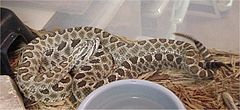Sistrurus tergeminus edwardsii
| Desert massasauga | |
|---|---|

| |
| Scientific classification | |
| Domain: | Eukaryota |
| Kingdom: | Animalia |
| Phylum: | Chordata |
| Class: | Reptilia |
| Order: | Squamata |
| Suborder: | Serpentes |
| Family: | Viperidae |
| Genus: | Sistrurus |
| Species: | |
| Subspecies: | S. t. edwardsii
|
| Trinomial name | |
| Sistrurus tergeminus edwardsii | |
| Synonyms[2] | |
| |
Sistrurus tergeminus edwardsii, also known as the desert massasauga, is a
Etymology
The subspecific name, edwardsii, is in honor of Colonel Dr. Lewis A. Edwards (1824–1877), a U.S. Army surgeon,[4] who collected the type specimen.[5] Common names include desert massasauga,[6] Edward's massasauga,[7] Edward's rattlesnake.[8]
Description

S. t. edwardsii is more slender and smaller than S. t. tergeminus, reaching a maximum total length (including tail) of 53 cm (21 in).[6]
Its color pattern consists of a light gray or white base color, with dark gray or gray-brown blotches. It has a distinctive, dark stripe that runs along the side of the head, which passes over the eye. The rattle is significantly higher pitched than those of larger species of rattlesnakes, sometimes giving it the nickname "buzztail".
Compared to S. t. tergeminus, it is paler in color, and its belly is nearly white. Midbody, it has 23 rows of dorsal scales instead of 25, and fewer ventral scales and dorsal blotches.[7]
Distribution
S. t. edwardsii is found in extreme southeastern
Habitat
S. t. edwardsii is primarily found in rocky, semiarid, and arid areas. According to Conant (1975), it is mostly found in desert grasslands.[6]
Behavior
This subspecies is primarily
Feeding
The diet of S. t. edwardsii consists primarily of rodents, lizards, and frogs.
Venom
Drop for drop, massasauga
Conservation status
The desert massasauga is listed as a species of concern in Colorado, due to its limited range in the state, and it is protected by Arizona state law. It is listed as a sensitive species by the United States Forest Service. NatureServe considers the subspecies Vulnerable.[1]
References
- ^ a b "Sistrurus tergeminus edwardsii. NatureServe Explorer 2.0". explorer.natureserve.org. Retrieved 24 March 2023.
- ^ ISBN 1-893777-01-4(volume).
- ^ "Sistrurus catenatus edwardsii ". Integrated Taxonomic Information System. Retrieved 31 January 2007.
- ISBN 978-1-4214-0135-5. (Sistrurus catenatus edwardsii, p. 81).
- ^ Baird & Girard (1853).
- ^ ISBN 0-395-19977-8(paperback).
- ^ ISBN 0-8014-0463-0.
- ^ Ditmars RL (1933). Reptiles of the World. Revised Edition. New York: The MacMillan Company. 329 pp. 89 plates.
- ISBN 0-520-21056-5.
- ISBN 0-8014-4141-2.
Further reading
- Baird SF, Girard CF (1853). Catalogue of North American Reptiles in the Museum of the Smithsonian Institution, Part I.—Serpents. Washington, District of Columbia: Smithsonian Institution. xvi + 172 pp. (Crotalophorus edwardsii, new species, p. 15.)
- Mackessy SP (2005). Desert Massasauga Rattlesnake (Sistrurus catenatus edwardsii): A Technical Conservation Assessment. USDA Forest Service. PDF at USDA Species Conservation Project. Accessed 31 January 2007.
- Yarrow HC(1875). "Chapter IV. Report upon the Collections of Batrachians and Reptiles made in Portions of Nevada, Utah, Colorado, New Mexico, and Arizona, during the Years 1871, 1872, 1873, and 1874". pp. 511–584. In: Report upon Geographical and Geological Explorations and Surveys West of the One Hundredth Meridian in Charge of First Lieut. Geo. M. Wheeler, Corps of Engineers, U.S. Army ... Vol. V.—Zoology. Washington, District of Columbia: Secretary of War, U.S. Government. 1,021 pp. (Caudisona edwardsii, pp. 531–532).
External links
- Sistrurus tergeminus at the Reptarium.cz Reptile Database. Accessed March 26, 2023.
- Sistrurus catenatus edwardsii at California Reptiles and Amphibians. Accessed 25 August 2007.

